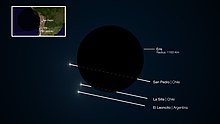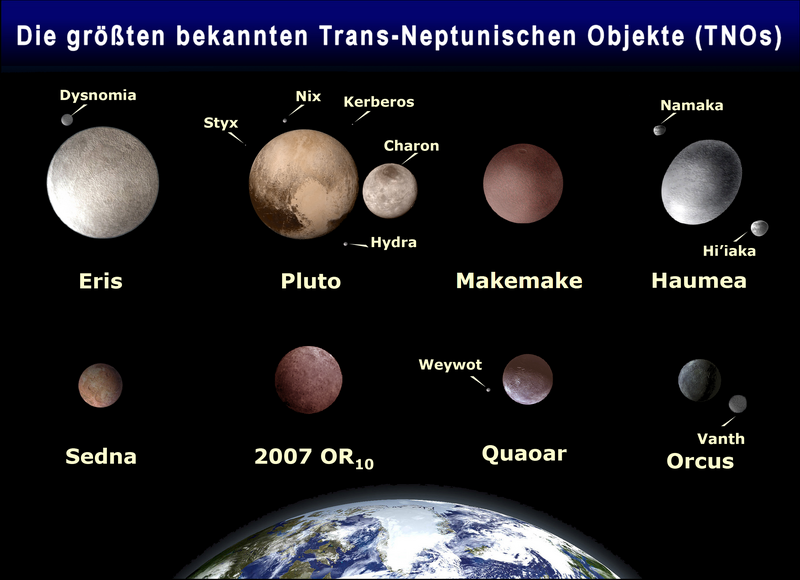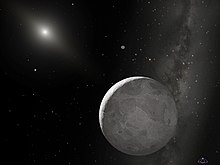(136199) Eris
|
Dwarf planet SDO (136199) Eris |
|
|---|---|
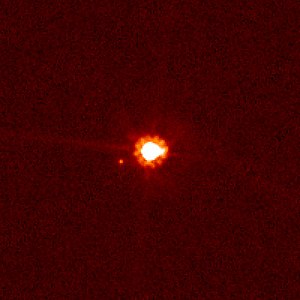
|
|
| Eris and her moon Dysnomia , photographed by the Hubble Space Telescope on August 30, 2006 | |
|
Properties of the orbit ( animation ) |
|
| Major semi-axis | 67,740 AU (10,134 million km) |
| Perihelion - aphelion | 38.272-97.457 AU |
| eccentricity | 0.436 |
| Inclination of the orbit plane | 44.144 ° |
| Sidereal period | 204203 ± 11 days (approx. 560 years) |
| Mean orbital velocity | 3.589 km / s |
| Physical Properties | |
| Equatorial diameter * | 2326 ± 12 km |
| Dimensions | 1.67 ± 0.02 · 10 22 kg |
| Medium density | 2.52 ± 0.05 g / cm 3 |
| Gravitational acceleration * | 0.827 ± 0.020 m / s 2 |
| Escape speed | 1.384 ± 0.01 km / s |
| Rotation period | 25.9 ± 0.5 h (1.079) d 14.0 h (0.583) d |
| Geometric albedo | |
| Max. Apparent brightness | 18.8 m |
|
Temperature * min. - average - max. |
30.0 K (−243.15 ° C) 42.5 K (−230.65 ° C) 55.0 K (−218.15 ° C) |
| * based on the zero level of the planet | |
| Others | |
| Moons | 1 |
| Explorer |
Michael E. Brown , Chadwick A. Trujillo , David L. Rabinowitz |
| Date of discovery | January 5, 2005 (pictures from 2003) July 29, 2005 (publication) |
(136199) Eris (earlier name 2003 UB 313 ) is the most massive and second largest known dwarf planet in the solar system after Pluto . Eris is one of the Plutoids , a subclass of dwarf planets that orbit the sun beyond the orbit of Neptune . Eris is currently the largest detected object in the solar system that has never been examined by a space probe ; it has a well-known moon called Dysnomia .
The dwarf planet is named after Eris , the Greek goddess of discord and strife. After their discovery was announced on July 29, 2005, NASA and many media outlets initially referred to this Trans-Neptunian object with a diameter similar to Pluto as the “ tenth planet ”. However, the International Astronomical Union (IAU) passed a new planet definition on August 24, 2006 , according to which Eris, like Pluto, was classified as a dwarf planet.
Eris moves on a strongly eccentric orbit that is inclined relative to the ecliptic around the sun , from which it was exactly 96 AU (14.4 billion kilometers) on February 20, 2020 . Due to their great eccentricity, they are included in orbital dynamics among the so-called "scattered" Kuiper belt objects (SDO), a subgroup of trans-Neptunian asteroids .
Discovery and naming
Discovery story
Eris was observed by a team of astronomers consisting of Mike Brown ( CalTech ), Chad Trujillo ( Gemini Observatory ) and Dave Rabinowitz ( Yale University ) on CCD images from October 21, 2003 of the 1.2-m-Oschin-Schmidt- Telescope discovered at Palomar Observatory, California . Because it moves slowly, it was overlooked when the images were first processed; the team's automatic image search program excluded all objects moving slower than 1.5 arc seconds per hour to reduce the number of false positives. When Sedna was discovered in 2003, it was moving at 1.75 arc seconds per hour. Eris was only discovered on January 5, 2005 beyond the Kuiper Belt after a new evaluation of the data, which were searched with a lower limit by the team with a view to the discovery of Sedna with the naked eye.
At first they wanted to publish their find only after further observations and better identification of the orbital elements . But after it became known that anyone could use a public website to query the orientation of one of the telescopes with which their discoverers had observed Eris, the researchers went public early on July 29, 2005 and announced the discovery, since only 19 hours a team of Spanish astronomers had previously announced their discovery of Haumea ; Brown's group had found the same object independently of them in 2004, but had not published anything about it until then. On the same day, Brown's group also announced the discovery of Makemake and Haumea; with it the public learned in a single day that three new large objects had been discovered in the Kuiper Belt.
Eris was the eighth discovery of a large TNO and likely dwarf planet by Mike Brown's team of astronomers. Brown's team successively discovered Quaoar and 2002 MS 4 (2002), Sedna (2003) and Haumea (2003, controversial), Orcus and Salacia (2004) and then Eris; Makemake (2005) and Gonggong (2007) followed.
After her discovery, Eris could be identified in photos up to September 3, 1954, which were also taken at the Palomar Observatory as part of the Digitized Sky Survey program , and so extended her observation period by 51 years, making her orbit more precise to calculate; the orbit data are therefore very reliably determined today. In October 2018, a total of 1089 observations over a period of 64 years were available. The last observation so far was carried out in February 2019 at the ATLAS telescope of the Haleakalā Observatory ( Maui ). (As of March 6, 2019)
Name and symbol
With the discovery publication, the IAU assigned the provisional designation 2003 UB 313 for Eris . It follows the usual rules for naming asteroids and only expresses in coded form that Eris was discovered in the second half of October (U) of the year 2003, in the order of the 7827th object found (B 313 ). The explorers' working group initially called Eris internally and unofficially "Xena" and her moon "Gabrielle", after two role names from the television series Xena - The Warrior Princess .
This was followed by the submission of the discovery team's proposal on September 6, 2006, and the permanent name was given: On September 13, 2006 - at the same time as Pluto - UB 313 received the minor planet number 136199 from the IAU in 2003 and at the same time the name Eris, her moon Name dysnomia . The names were assigned according to the IAU naming protocols for planetoids.
In Greek mythology , Eris is the goddess of discord and strife, whose intrigue sparked the Trojan War . Her daughter, the demon of lawlessness, is called Dysnomia . Both names give an indication of the bitter controversy which, after its discovery, ultimately led to the redefinition of the term "planet" and the withdrawal of the planetary status of Pluto . There is also a reference to the originally chosen job title “Xena”. The film character Xena was played by the actress Lucy Lawless . Lawlessness is the English term for lawlessness, to which the assignment of the name Dysnomia alludes.
Unlike Pluto or Ceres, like most dwarf planets, Eris has no official or commonly used astronomical symbol . There are a few designs, but they all come from private individuals. Since the best-known myth of the goddess Eris is that of the apple of contention ![]() , some designs are based on it. The goddess Eris also plays a central role in Discordianism , which is why the Discordian symbol hand of Eris
, some designs are based on it. The goddess Eris also plays a central role in Discordianism , which is why the Discordian symbol hand of Eris ![]() was discussed as a possible Eris symbol and proposed in a petition to the IAU in 2005. However, this petition has not yet been accepted.
was discussed as a possible Eris symbol and proposed in a petition to the IAU in 2005. However, this petition has not yet been accepted.
None of these suggested symbols have been officially recognized or used by the International Astronomical Union (IAU) or equivalent, or have gained widespread use. It is not foreseeable that this will ever happen, as astronomical symbols only play a subordinate role in modern astronomy.
Track properties
Orbit
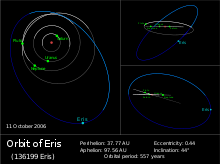
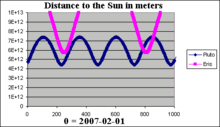
Eris orbits the sun in 557.55 years on a strongly elliptical orbit, not uncommon for an object in the Kuiper belt, between 38.01 AU and 97.47 AU from its center and therefore does not cross the orbit of Neptune. The orbital eccentricity is 0.439, the orbit is 44.14 ° inclined to the ecliptic . Currently, Eris is 96.07 AU away from the Sun, near the aphelion of its orbit, which is 97.46 AU and which it passed in 1977. This corresponds to a distance of about 13.5 light hours and almost two and a half times the mean distance from Pluto to the sun. She passed through perihelion for the last time in 1701, so the next perihelion should take place in 2258.
The strong inclination of the orbit is striking, which is quite unusual for a body of this size and probably delayed discovery. Most search programs for Kuiper Belt Objects (KBOs) or other asteroids limit themselves to positions in the approximate vicinity of the ecliptic, since this is where most of the matter in the solar system is concentrated. It is possible that Eris was steered into this orbit by the gravitational influence of Neptune .
Since its discovery, Eris has been the most distant object discovered - apart from a few much smaller long-period comets - until it was replaced in this area by 2018 VG 18 (124.8 AU) in 2018 . Also, Eris will be overtaken by Gonggong in 2045 in terms of solar distance . However, Eris is far from being the object with the furthest known orbit, as its semi-major axis is estimated to be "only" 67.7 AU, while the semi-axis of the current record holder 2014 FE 72 is around 1505 AU. There are about 40 known TNOs, such as Sedna (84.9 AU), 2006 SQ 372 and 2000 OO 67 , which are currently closer to the Sun than Eris, although their semi-axes are larger. In about 800 years, Eris will be closer to the sun than Pluto for some time.
Due to the high incline of the orbit, Eris only passes a few constellations in the traditional zodiac on its orbit ; it is currently in the southern sky in the constellation whale . She was in the sculptor from 1876 to 1929 and previously in the Phoenix from around 1840 to 1875 . It will be in the Pisces constellation from 2036 and then enter the Aries constellation from 2065 . From there it passes the ecliptic towards the northern sky, where it will change to the constellation Perseus from 2128 and in 2173 to the constellation Giraffe , where it will reach its northernmost position.
Orbit dynamics classification
Both Marc Buie ( DES ) and the Minor Planet Center classify the planetoid as SDO ; the latter also generally lists it as a distant object .
SDOs are objects that moved from original orbits in the Kuiper Belt to more distant and unusual orbits through gravitational interactions with the planet Neptune in the early phase of the solar system . Although Eris' high inclination is unusual even for an SDO, theoretical models indicate that objects originally located on the inner edge of the Kuiper Belt have entered more inclined orbits than objects on the outer edge. The objects of the inner Kuiper belt are generally expected to have a higher mass than objects of the outer belt, so astronomers expect to find larger planetoids in highly inclined orbits, which traditional planet- search surveys have traditionally neglected.
Physical Properties
Size and mass
On November 5, 2010, the size of Eris could be determined quite accurately by an occultation of 2326 ± 12 kilometers. The eclipse was visible in Chile and was recorded by three telescopes. The diameter results from the periods of coverage and the distances between the telescopes across the observation line. This gives an albedo of 0.96, which is higher than any other large body in the solar system, with the exception of Enceladus , which has a reflectivity of even 0.99. Eris is therefore largely spherical and was therefore considered to be somewhat larger than Pluto, whose diameter was estimated at 2306 km. With the more precise measurement of Pluto by the New Horizons probe in July 2015, the diameter of Pluto was determined to be 2,374 km and is therefore larger than Eris. Mike Brown, on the other hand, still assumes that Eris with 2330 km is larger than Pluto with 2329 km, based on an albedo of 0.99 like Enceladus and an absolute brightness of −1.1 m . According to the current state of knowledge, the absolute brightness of Eris is −1.17 +0.06−0.11 m .
The mass of Eris could be calculated with some precision from the movement of the moon Dysnomia, based on the currently accepted orbital period of Dysnomia of 15.8 days. According to this, its mass is about 0.27% that of the earth, and it has about 27% more mass than Pluto, although it has the larger diameter. In terms of mass, Eris ranks ninth among the celestial bodies that directly orbit the sun and 16th in the entire solar system, since seven moons have a higher mass than Eris. This results in a comparatively high average density of 2.52 g / cm³, which means that Eris is much denser than Pluto and its proportion of rock must therefore be higher.
On the history of sizing
In order to determine the size of an object from its apparent brightness , which at Eris' current position is about 18.8 m , both its distance and its albedo (reflectivity) must be known. Then its size can be calculated; a lower albedo leads to a larger value of the diameter with the same apparent brightness. Even with the highest possible albedo of 1, i.e. if it reflected all light, according to Brown's calculations Eris would still be at least as large as Pluto was estimated at the time. Since it was not found by the Spitzer Space Telescope , the first reports said that its diameter must be less than 3200 kilometers. In the meantime it turned out that the telescope was not aligned with the object due to an operator error.
Radio astronomers at the Max Planck Institute for Radio Astronomy in Bonn made the first reliable measurement of size in early 2005 . Using the IRAM - radio telescope at Veleta in southern Spain, they measured the thermal radiation of Eris. In combination with optical observations, the albedo was narrowed down to 0.60 ± 0.11 and, from this, the diameter to 3000 ± 320 kilometers.
The exploration team received observation time on the Hubble Space Telescope in 2005 . Although the device already reaches the limits of its capabilities with an angular diameter of an object of only 0.035 arcseconds , Brown's team was able to use special image processing techniques ( deconvolution ) to determine the size of Eris to be 2400 ± 100 kilometers. As a result, Eris was smaller than previous measurements suggested, about the same size as Pluto. Here the albedo of Eris was determined to be 0.85 ± 0.07. In 2010 the star occultation followed, through which its size could then be determined to be 2326 km.
| year | Dimensions km | source |
|---|---|---|
| 2006 | 3000.0 ± 400.0 (system) | Bertoldi et al. a. |
| 2006 | 2400.0 ± 100.0 | Brown et al. a. |
| 2007 | 2400.0 ± 100.0 | Brown et al. a. |
| 2008 | 2400.0 | Tancredi |
| 2010 | 2600.0 | Tancredi |
| 2010 | <2320.0 | Maury et al. a. |
| 2011 | 3263.4 (system) 3260.0 ± 740 |
Grundy et al. a. |
| 2011 | 2326.0 ± 12.0 | Sicardy et al. a. |
| 2012 | 2434.0 ± 117.0 2356.0 ± 117.0 |
Santos-Sanz et al. a. |
| 2013 | 2700.0 | LightCurve DataBase |
| 2018 | 2429.0 | Brown et al. a. |
| 2018 | 2330.0 | Brown |
| The most precise determination is marked in bold . | ||
Size comparison
Physical classification: the tenth planet?
The media called Eris, like Quaoar and Sedna , the “tenth planet” (→ Transpluto ). The explorers and NASA did the same. Such a classification appeared plausible from the point of view of the experts, because on the one hand Eris even appeared to be larger than Pluto , and on the other hand there were already features of the planet definition for the planetary status of the latter - limits for the eccentricity and the condition that a planet has a greater mass than all other objects in its orbit - ignored. But since the late 1990s many astronomers tended not to include Pluto itself among the planets; instead, they referred to it as the largest Trans-Neptunian object to date . The discovery of Eris reignited the debate about which characteristics celestial bodies should count as planets.
The 26th General Assembly of the International Astronomical Union in Prague in August 2006 then adopted a new official definition for planets and dwarf planets . Accordingly, Eris, Pluto and Ceres are now considered dwarf planets. The status of Sedna and Quaoar is still unclear. At the same time, a subclass for trans-Neptunian dwarf planets was defined, which should initially be called plutons . This name was discarded in favor of the new name Plutoids , which now includes the namesake Pluto as well as Eris.
rotation
Using light curve observations in 2008, Eris rotates once around its axis in 25 hours and 54 minutes. From this it follows that in one Eris year it performs 188704.6 self- rotations (“days”). However, this is still fraught with uncertainties, as the observation time at that time was insufficient and the error rate is around 30%. According to another result, it would take almost half as long to do this, at 14 hours, which would increase the number of Eris days in its year to 349 103.5 revolutions. However, the latter variant is seen as the less likely. Overall, there seems to be a lot of uncertainty about the rotation, especially since the results range from 8 to 32.5 hours.
The current color indices are BV = 0.750 ± 0.020, VR = 0.430 ± 0.020, VI = 0.780 ± 0.010, BR = 1.180 ± 0.020.
Surface and atmosphere

The arrows show the absorption bands of methane.
Eris is big enough to hold a very thin atmosphere of nitrogen , methane, or carbon monoxide . This would similar to Pluto periodically with increasing distance from the Sun and the drop in surface temperature on the surface resublimation again when re-rise in the temperature sublimate and again form an atmosphere. Spectroscopic observations at the Gemini Observatory in Hawaii by the discovery team on January 25, 2005 indicate the presence of frozen methane on the surface of Eris. Furthermore, frozen nitrogen could be detected on the surface, whereby its concentration changed significantly between 2005 and 2007 according to investigations with the "Multiple Mirror Telescope" on Mount Hopkins in Arizona.
In contrast to the darker, reddish Pluto or Triton , Eris has a light, white color. Pluto's red color is attributed to coverage by deposits of tholine ; while they darken the surface, the deeper albedo leads to higher temperatures and the sublimation of methane deposits. The presence of the highly volatile methane suggests that Eris must have always been in the remote areas of the solar system, where temperatures were cold enough to keep methane ice on the surface. In Eris' further distance from the sun, methane can also condense on the surface in areas with a lower albedo, so that any tholine deposits would be covered. The surface temperature of Eris is estimated to be at least 30 K (about −243 ° C) in aphelion . It is thus significantly lower than that of Pluto. The main causes are the high albedo of 99% and the greater distance to the sun. Due to its orbital eccentricity, Eris experiences a temperature difference of about 25 ° C in one orbit of the sun, which is quite unusual for a TNO. Since Eris is currently very close to her furthest point from the sun , no atmosphere can be present at the moment.
Based on a diameter of 2326 km, the total surface area is around 16,997,000 km², which is just about the size of Russia . Eris is too far away to be able to make out surface details on her with the currently available instruments.
construction
Some sources speak of a composition of around 70 percent rock and 30 percent frozen water. So Eris shows more similarity to Pluto and its moon Charon than to the other KBOs .; the high albedo assumed due to its small size also supports this. Mainly because of the high reflectivity, it is speculated whether the surface ice will be renewed by internal processes due to temperature changes due to the variable distance to the sun; Due to its small size (compared to geologically active planets such as Earth ) and its formation on the outer edge of the solar system, it should not have any significant internal energy sources. The tidal warmth of the moon Dysnomia could also slightly influence the temperature, if it is of sufficient mass. Models of internal heating from radioactive decay show that Eris may be able to sustain an ocean of liquid water below its surface.
Possible exploration by spacecraft
In the 2010s, several studies were presented that included additional targets for exploring the Kuiper Belt and the Trans-Neptunian area in the course of the successful Pluto flyby in July 2015, and Eris was also one of the candidates.
2011 has been calculated that a flyby mission would need to Eris 24.66 years; a swing-by to Jupiter would be planned for this, based on start dates on April 3, 2032 or April 7, 2044. Eris would then be 92.03 rsp. when the probe arrives. 90.19 AU from the Sun. The probe would reach Eris in 2056 and 2068 respectively.
Moon dysnomia
Eris owns a moon called Dysnomia , which was discovered on September 10, 2005 by the same team as Eris and announced by the IAU in October 2005. Since Dysnomia has about the 500th part of the luminosity of Eris, the diameter could be about 100 km. If Dysnomia's albedo were much smaller than that of Eris, the diameter could be 350 km or more. Dysnomia needs almost 16 days to orbit the dwarf planet, its distance to Eris is about 37,000 kilometers.
The Eris system at a glance:
| Components | Physical parameters | Path parameters | discovery | |||||
|---|---|---|---|---|---|---|---|---|
| Surname | Throughput diameter (km) |
Relative size % |
Mass (kg) |
Major semi-axis (km) |
Orbital time (d) |
eccentricity |
Inclination to Eris' equator |
Date of discovery Date of publication |
|
(136199) Eris |
2326.0 | 100.00 | 4.40 · 10 21 | - | - | - | - | January 5, 2005 July 29, 2005 |
|
Dysnomia (Eris I) |
100-700 | ? | 1 · 10 19 | 37460 | 15.78586 | 0.004 | 61.1 ° | September 10, 2005 October 2, 2005
|
See also
- Planet nine
- List of trans-Neptunian objects
- List of dwarf planets of the solar system
- List of moons of planets and dwarf planets
- List of moons from asteroids
- List of asteroids
literature
- C. Dumas, F. Merlin, MA Barucci, C. de Bergh, O. Hainault, A. Guilbert, P. Vernazza, A. Doressoundiram: Surface composition of the largest dwarf planet 136199 Eris (2003 UB 313 ) . In: Astronomy & Astrophysics . tape 471 , no. 1 . EDP Sciences, 2007, pp. 331-334 .
- Frank Bertoldi et al .: The trans-neptunian object UB 313 is larger than Pluto . In: Nature . 439, No. 7076, 2005, pp. 563-564. doi: 10.1038 / nature04494 .
- ME Brown , CA Trujillo, DL Rabinowitz: Discovery of a planetary-sized object in the scattered Kuiper belt . In: The Astrophysical Journal . 635, 2005, L97-L100, doi: 10.1086 / 499336 , arxiv : astro-ph / 0508633
- Mike Brown: How I hunted down Pluto. And why he didn't deserve it any other way . Springer, Heidelberg 2012, ISBN 978-3-8274-2944-5 .
- R. Vaas: The tenth planet . In: Naturwissenschaftliche Rundschau . No. 1, 2006, pp. 5-13.
Web links
- Mike Brown's website about 2003 UB 313 (English)
- ESO: Eris, Pluto's distant twin + Animations - October 26, 2011
Media reports
- The tenth planet - or not - How do you define a planet? New celestial body brings fresh momentum to old debate
- Tenth planet "Xena" has a moon nicknamed "Gabrielle"
- Message from ORF
Individual evidence
- ↑ a b (136199) Eris in the Small-Body Database of the Jet Propulsion Laboratory (English). Retrieved March 6, 2019.
- ↑ v ≈ π * a / period (1 + sqrt (1-e²))
- ↑ a b M. Brown , E. Schaller: The Mass of Dwarf Planet Eris (PDF) . In: Science . 316, No. 5831, June 15, 2007, p. 1585. bibcode : 2007Sci ... 316.1585B . doi : 10.1126 / science.1139415 .
- ↑ a b B. Sicardy et al. a .: Size, density, albedo and atmosphere limit of dwarf planet Eris from a stellar occultation (PDF) . In: EPSC Abstracts . October 6, 2011. bibcode : 2011epsc.conf..137S .
- ↑ a b AstDyS-2: (136199) Eris . Universita di Pisa. Retrieved March 6, 2019.
- ↑ J. Platt et al. a .: NASA Funded Scientists Discover Tenth Planet . NASA . July 29, 2005. Retrieved March 6, 2019.
- ↑ a b D. Green: IAUC No. 8577: 2003 EL_61, 2003 UB_313, 2005 FY_9 . In: IAU : Central Bureau for Astronomical Telegrams (CBAT) . July 29, 2005.
- ↑ MPC : MPEC 2005-041: 2003 UB313 . IAU . July 29, 2005. Retrieved March 6, 2019.
- ↑ a b (136199) Eris at the IAU Minor Planet Center (English) Retrieved March 6, 2019.
- ↑ D. Green: IAUC No. 8747: (134340) Pluto, (136199) Eris, and (136199) Eris I (Dysnomia) . In: IAU : Central Bureau for Astronomical Telegrams (CBAT) . September 13, 2006. PDF
- ↑ MPC : Discovery Circumstances: Numbered Minor Planets (135001) - (140000) . IAU . October 29, 2018. Retrieved March 6, 2019.
- ↑ MPC : MPC / MPO / MPS Archive . IAU . Retrieved March 6, 2019.
- ↑ Dwarf Planet 2003 UB313 got the name Eris. Kuffner Observatory, September 14, 2006, accessed December 22, 2015 .
- ^ K. Le Grice: Discovering Eris: The Symbolism and Significance of a New Planetary Archetype . Edinburgh 2012, ISBN 978-0-86315-867-4 .
- ^ M. Buie : Orbit Fit and Astrometric record for 136199 . SwRI (Space Science Department). Retrieved March 6, 2019.
- ↑ MPC : MPEC List Of Centaurs and Scattered-Disk Objects . IAU . Retrieved March 6, 2019.
- ↑ MPC : MPEC 2010-S44: Distant Minor Planets (2010 OCT.11.0 TT) . IAU . September 25, 2010. Retrieved March 6, 2019.
- ^ Wm. R. Johnston: List of Known Trans-Neptunian Objects . Johnston's Archives. October 7, 2018. Retrieved March 6, 2019.
- ↑ R. Gomes et al. a .: On The Origin of The High-Perihelion Scattered Disk: The Role of The Kozai Mechanism And Mean Motion Resonances (PDF) . In: Celestial Mechanics and Dynamical Astronomy . 91, No. 1-2, May 8, 2005, pp. 109-129. bibcode : 2005CeMDA..91..109G . doi : 10.1007 / s10569-004-4623-y .
- ↑ Beatty, Kelly: Former 'tenth planet' may be smaller than Pluto . NewScientist.com. Sky and Telescope. November 8, 2010. Retrieved March 6, 2019.
- ↑ a b B. Sicardy et al. a .: A Pluto-like radius and a high albedo for the dwarf planet Eris from an occultation (PDF) . In: Nature . 478, No. 7370, 2011, pp. 493-496. bibcode : 2011Natur.478..493S . doi : 10.1038 / nature10550 .
- ↑ R. Kayser: Eris: Isn't Pluto the largest dwarf planet? . CalTech . November 10, 2010. Retrieved March 6, 2019.
- ^ D. Williams: Pluto Fact Sheet . NASA . December 23, 2016. Accessed March 6, 2019.
- ↑ a b M. Brown : How many dwarf planets are there in the outer solar system? . CalTech . November 12, 2018. Retrieved March 6, 2019.
- ↑ F. Bertoldi et al. a .: Newly discovered "planet" is larger than Pluto . MPIfR . February 1, 2006. Accessed March 6, 2019.
- ↑ a b M. Brown et al. a .: Direct Measurement of the Size of 2003 UB313 from the Hubble Space Telescope (PDF) . In: The Astrophysical Journal . 643, No. 1, April 11, 2006, pp. L61-L63. arxiv : astro-ph / 0604245 . bibcode : 2006ApJ ... 643L..61B . doi : 10.1086 / 504843 .
- ↑ F. Bertoldi et al. a .: The trans-neptunian object UB 313 is larger than Pluto . In: Nature . 439, No. 7076, February 2, 2006, pp. 563-564. bibcode : 2006Natur.439..563B . doi : 10.1038 / nature04494 .
- ^ G. Tancredi, S. Favre: DPPH List . In: Dwarf Planets and Plutoid Headquarters, from Which are the dwarfs in the solar system? . August. Retrieved March 6, 2019.
- ^ G. Tancredi: Physical and dynamical characteristics of icy “dwarf planets” (plutoids) (PDF) . In: International Astronomical Union (Ed.): Icy Bodies of the Solar System: Proceedings IAU Symposium No. 263, 2009 . 2010. doi : 10.1017 / S1743921310001717 . Retrieved March 6, 2019.
- ↑ A. Maury et al. a .: IAUC No. 9185: Occultation by (136199) Eris . In: IAU : Central Bureau for Astronomical Telegrams (CBAT) . November 2010. bibcode : 2010IAUC.9185 .... 1M .
- ↑ W. Grundy et al. a .: Five New and Three Improved Mutual Orbits of Transneptunian Binaries (PDF) . In: Icarus . 213, No. 2, March 14, 2011, pp. 678-692. arxiv : 1103.2751 . bibcode : 2011Icar..213..678G . doi : 10.1016 / j.icarus.2011.03.012 .
- ↑ P. Santos-Sanz et al. a .: “TNOs are Cool”: A Survey of the Transneptunian Region IV. Size / albedo characterization of 15 scattered disk and detached objects observed with Herschel Space Observatory-PACS (PDF) . In: Astronomy and Astrophysics . 541, No. A92, February 7, 2012, p. 18. arxiv : 1202.1481 . bibcode : 2012A & A ... 541A..92S . doi : 10.1051 / 0004-6361 / 201118541 .
- ↑ LCDB Data for (136199) Eris . MinorPlanetInfo. 2018. Retrieved March 6, 2019.
- ^ M. Brown , B. Butler: Medium-sized satellites of large Kuiper belt objects . In: Earth and Planetary Astrophysics . January 22, 2018. arxiv : 1801.07221 . doi : 10.3847 / 1538-3881 / aad9f2 .
- ↑ D. Tytell: Astronomers Discover “10th Planet”. Sky & Telescope, October 4, 2005, accessed March 6, 2019 .
- ^ R. Britt: Object Bigger than Pluto Discovered, Called 10th Planet. Space.com, July 29, 2005, accessed March 6, 2019 .
- ↑ H. Roe et al. a .: Tentative Detection of the Rotation of Eris (PDF) . In: Icarus . 198, No. 2, September 4, 2008, pp. 459-464. arxiv : 0808.4130 . bibcode : 2008Icar..198..459R . doi : 10.1016 / j.icarus.2008.08.001 .
- ↑ M. Brown et al. a .: A study of photometric variations on the dwarf planet (136199) Eris . In: Astronomy and Astrophysics . 479, No. 3, March 2008, pp. 877-881. bibcode : 2008A & A ... 479..877D . doi : 10.1051 / 0004-6361: 20078619 .
- ↑ J. Petit et al. a .: IAUC No. 8596: 2003 UB_313 . In: IAU : Central Bureau for Astronomical Telegrams (CBAT) . September 8, 2005. bibcode : 2005IAUC.8596 .... 3P .
- ↑ a b c S. Tegler u. a .: Two Color Populations of Kuiper Belt and Centaur Objects and the Smaller Orbital Inclinations of Red Centaur Objects (PDF) . In: The Astronomical Journal . 152, No. 6, December 2016, p. 210, 13. bibcode : 2016AJ .... 152..210T . doi : 10.3847 / 0004-6256 / 152/6/210 .
- ↑ I. Belskaya et al. a .: Updated taxonomy of trans-neptunian objects and centaurs: Influence of albedo . In: Icarus . 250, April 2015, pp. 482-491. bibcode : 2015Icar..250..482B . doi : 10.1016 / j.icarus.2014.12.004 .
- ↑ R. Kayser: Enigmatic processes on Eris . Science up to date. November 11, 2008. Retrieved March 6, 2019.
- ↑ M. Brown et al. a .: Discovery of a planetary-sized object in the scattered Kuiper belt (PDF) . In: The Astrophysical Journal . 635, No. 1, November 22, 2005, pp. L97-L100. arxiv : astro-ph / 0508633 . bibcode : 2005ApJ ... 635L..97B . doi : 10.1086 / 499336 .
- ↑ J. Licandro et al. a .: Visible spectroscopy of 2003 UB 313 : evidence for N 2 ice on the surface of the largest TNO? (PDF) . In: Astronomy and Astrophysics . 458, No. 1, October 4, 2006, pp. L5-L8. arxiv : astro-ph / 0608044 . bibcode : 2006A & A ... 458L ... 5L . doi : 10.1051 / 0004-6361: 20066028 .
- ↑ M. Brown : The discovery of Eris, the largest known dwarf planet . CalTech . Retrieved March 6, 2019.
- ↑ H. Hussmann et al. a .: Subsurface oceans and deep interiors of medium-sized outer planet satellites and large trans-neptunian objects (PDF) . In: Icarus . 185, No. 1, November 2006, pp. 258-273. arxiv : 0910.4784 . bibcode : 2006Icar..185..258H . doi : 10.1016 / j.icarus.2006.06.005 .
- ↑ SwRI team makes breakthroughs studying Pluto orbiter mission . Astrobiology Magazine. October 25, 2018. Retrieved March 6, 2019.
- ↑ R. McGranaghan et al. a .: A Survey of Mission Opportunities to Trans-Neptunian Objects . In: Journal of the British Interplanetary Society . 64, 2011, pp. 296-303. bibcode : 2011JBIS ... 64..296M .
- ↑ D. Green: IAUC No. 8610: S / 2005 (2003 UB_313) 1 . In: IAU : Central Bureau for Astronomical Telegrams (CBAT) . October 4, 2005.
- ↑ M. Brown : The moon of the 10th planet . CalTech . Retrieved March 6, 2019.
- ^ Wm. R. Johnston: Asteroids with Satellites - (136199) Eris and Dysnomia . Johnston's Archives. September 23, 2018. Retrieved March 6, 2019.



